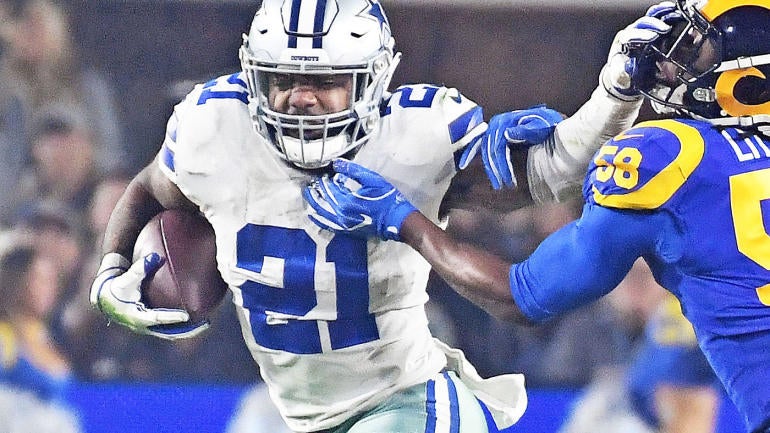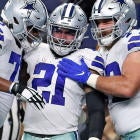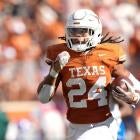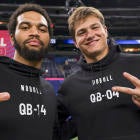
There comes a point in every Fantasy football draft where you'll look at the running backs left on the board and realize you're not cool with starting any of them. Determining where that point depends on how risk-averse you are and what the scoring is in your particular league, but it's vital to building a winning roster.
You don't have to worry about any of these things through the first three tiers at running back. Nearly every player among the 18 listed is considered reliable, though you might take issue with a rookie like Clyde Edwards-Helaire or an injury risk like James Conner being among them. That's OK, just scan them and know before your draft how many of those 18 you'd be OK starting.
Then do the same with the fourth and fifth Tiers. Not feeling as many guys, right? The fewer of those running backs you like, the more running backs from the first three tiers you'll lean toward drafting.
The remaining tiers are a mixture of guys whose names you'll recognize along with "lottery ticket" players who COULD become special if they land regular playing time. There's rarely a shortage of those running backs, just a shortage of patience from Fantasy managers who don't want to roster a guy who doesn't play every snap. You may find some backs you won't mind being patient with. Prioritize them along with the runners you'd be OK starting if you had to,
RB strategies
For years, I've been called "a running back guy." Is that a bad thing? Of course not, silly! Why not load up on the position that scores more Fantasy points than pass catchers, or is the most valuable trade commodity, or is the most prone to injuries? Why not build up a roster with guys who could go from zeroes to heroes thanks to an injury or a benching? And don't you usually have to start at least two running backs in your league?
Put it on my tombstone:
HERE LIES
DAVE RICHARD
FATHER
HUSBAND
RUNNING BACK GUY
So, for me, the question isn't whether or not to collect running backs on Draft Day, it's HOW to do it.
I'd normally suggest going over the running back tiers (or any set of rankings you like) to get an idea of just how many running backs in the talent pool you'd trust in your lineup, but the reality is that most Fantasy drafters are going to aggressively take rushers this year because of the depth at wide receiver, quarterback and even tight end. Literally every round of 12-team-or-fewer leagues can you find someone at those positions you'd at least tolerate having on your team.
You can't quite say the same about running backs, especially once you get to Round 6 or 7 and you're staring at part-time players who might have low ceilings. So if you DON'T load up early, have some antacid nearby because you're not gonna feel so good taking running backs you'd need to start later than that. That's my preferred strategy this year.
My least preferred strategy is waiting to take a running back until that Round 6 or 7 range. That's called Zero RB, you know, and I feel like it'll mean zero Fantasy points from your running backs if you go that route in 2020. There are just too many unpredictable backfield splits with solid players. Maybe you could make the case for waiting at running back and beginning the year with a duo like Jordan Howard and Marlon Mack, but it's not ideal when the rest of your league is taking better running backs early and not missing out much on other positions.
So allow me to pitch you on a modified version of that. I like to call it Solo RB. Instead of ignoring running backs through your first five or six picks, you take just one. One guy to be the crown jewel of your backfield while you farm others during the draft and season via mid- to late-round picks and waiver-wire adds. In the case of Solo RB, the lone weak spot in your lineup is the second running back you start each week.
A year for insurance
Let's take this moment to talk about COVID-19 and the impact it figures to have on running backs. You should already know that running backs tend to get injured at a higher rate than their skill-position counterparts. Now we're throwing in the threat of testing positive for COVID-19, which is something that can happen to anyone in football, or in life.
If you draft a running back who ends up missing time because of COVID-19, you'd love to have his backup ready to go. Not all backups are created equally -- do you really think Reggie Bonnafon can replicate Christian McCaffrey's stats? -- but the real-life backups who can produce close to what the starters in front of them can are worth taking. This year especially, it's wise to have the guy behind the guy on your bench.
Here's how I have the handcuff options ranked for 2020.
Skip the rookies?
There were no offseason programs or minicamps, training camps are sure to have limited practices, and there are no preseason games. It sure puts all rookies in a tight spot.
The good news for running backs is that the things they'll be asked to do figure to be things they've done for years -- namely follow their blockers and run. That should come naturally, especially after adapting to the speed of the NFL game. It's stuff like pass protection, learning routes and developing chemistry with the quarterback figures to limit the playing time of most rookies right away. Those who proved their efficiency in college on passing downs won't have a learning curve as steep. Sadly, the only ones we can confidently say that about are Clyde Edwards-Helaire, D'Andre Swift, Cam Akers and Antonio Gibson.
If you prefer your running backs with track records, then it's fine to bypass the rookie class. But there's loads of potential with several who could do what Miles Sanders and Devin Singletary did last year and break out in the second half of the season. Again, your own patience should be a factor.
The bottom line
- As usual, running back is the thinnest position on Draft Day.
- As usual, running backs are still the hottest Fantasy commodity.
- Expect the majority of Fantasy drafters to take running backs early to shore up the position.
- Drafting insurance policies is more recommended than ever thanks to COVID-19.
- It's recommended everyone should end their drafts with at least 40% of their roster being running backs.
E. Elliott
NE
Ezekiel Elliott
NE
|
S. Barkley
PHI
Saquon Barkley
PHI
|
A. Kamara
NO
Alvin Kamara
NO
|
D. Cook
BAL
Dalvin Cook
BAL
|
M. Sanders
CAR
Miles Sanders
CAR
|
K. Drake
GB
Kenyan Drake
GB
|
A. Ekeler
WAS
Austin Ekeler
WAS
|
D. Henry
BAL
Derrick Henry
BAL
|
J. Jacobs
GB
Josh Jacobs
GB
|
N. Chubb
CLE
Nick Chubb
CLE
|
A. Jones
MIN
Aaron Jones
MIN
|
J. Conner
ARI
James Conner
ARI
|
C. Carson
SEA
Chris Carson
SEA
|
M. Gordon
BAL
Melvin Gordon
BAL
|
T. Gurley
ATL
Todd Gurley
ATL
|
L. Bell
TB
Le'Veon Bell
TB
|
D. Johnson
NO
David Johnson
NO
|
D. Singletary
NYG
Devin Singletary
NYG
|
R. Jones
DAL
Ronald Jones
DAL
|
M. Ingram
NO
Mark Ingram
NO
|
L. Fournette
BUF
Leonard Fournette
BUF
|
D. Swift
CHI
D'Andre Swift
CHI
|
J. Taylor
IND
Jonathan Taylor
IND
|
R. Mostert
MIA
Raheem Mostert
MIA
|
D. Montgomery
DET
David Montgomery
DET
|
K. Hunt
CLE
Kareem Hunt
CLE
|
T. Cohen
CAR
Tarik Cohen
CAR
|
J. White
NE
James White
NE
|
J. Howard
NO
Jordan Howard
NO
|
J. Dobbins
BAL
J.K. Dobbins
BAL
|
M. Mack
ARI
Marlon Mack
ARI
|
M. Breida
NYG
Matt Breida
NYG
|
D. Guice
WAS
Derrius Guice
WAS
|
P. Lindsay
IND
Phillip Lindsay
IND
|
A. Gibson
NE
Antonio Gibson
NE
|
S. Michel
LAR
Sony Michel
LAR
|
N. Hines
CLE
Nyheim Hines
CLE
|
K. Johnson
PHI
Kerryon Johnson
PHI
|
T. Coleman
SF
Tevin Coleman
SF
|
T. Pollard
TEN
Tony Pollard
TEN
|
C. Edmonds
TB
Chase Edmonds
TB
|
B. Scott
PHI
Boston Scott
PHI
|
L. Murray
BUF
Latavius Murray
BUF
|
D. Washington
MIA
DeAndre Washington
MIA
|
A. Dillon
GB
A.J. Dillon
GB
|
R. Armstead
JAC
Ryquell Armstead
JAC
|
L. McCoy
TB
LeSean McCoy
TB
|
D. Evans
BUF
Darrynton Evans
BUF
|
D. Johnson
BUF
Duke Johnson
BUF
|
C. Hyde
JAC
Carlos Hyde
JAC
|
D. Harris
BUF
Damien Harris
BUF
|
J. Kelley
LAC
Joshua Kelley
LAC
|
A. McFarland
PIT
Anthony McFarland
PIT
|
K. Vaughn
NE
Ke'Shawn Vaughn
NE
|
M. Brown
LAR
Malcolm Brown
LAR
|
J. Williams
NO
Jamaal Williams
NO
|
A. Peterson
SEA
Adrian Peterson
SEA
|
G. Bernard
TB
Giovani Bernard
TB
|
D. Freeman
BAL
Devonta Freeman
BAL
|
C. Thompson
CHI
Chris Thompson
CHI
|
E. Elliott
NE
Ezekiel Elliott
NE
|
S. Barkley
PHI
Saquon Barkley
PHI
|
A. Kamara
NO
Alvin Kamara
NO
|
D. Henry
BAL
Derrick Henry
BAL
|
D. Cook
BAL
Dalvin Cook
BAL
|
M. Sanders
CAR
Miles Sanders
CAR
|
J. Jacobs
GB
Josh Jacobs
GB
|
N. Chubb
CLE
Nick Chubb
CLE
|
K. Drake
GB
Kenyan Drake
GB
|
A. Ekeler
WAS
Austin Ekeler
WAS
|
A. Jones
MIN
Aaron Jones
MIN
|
J. Conner
ARI
James Conner
ARI
|
C. Carson
SEA
Chris Carson
SEA
|
M. Gordon
BAL
Melvin Gordon
BAL
|
T. Gurley
ATL
Todd Gurley
ATL
|
L. Bell
TB
Le'Veon Bell
TB
|
M. Ingram
NO
Mark Ingram
NO
|
R. Jones
DAL
Ronald Jones
DAL
|
D. Johnson
NO
David Johnson
NO
|
D. Singletary
NYG
Devin Singletary
NYG
|
L. Fournette
BUF
Leonard Fournette
BUF
|
D. Swift
CHI
D'Andre Swift
CHI
|
R. Mostert
MIA
Raheem Mostert
MIA
|
J. Taylor
IND
Jonathan Taylor
IND
|
D. Montgomery
DET
David Montgomery
DET
|
J. Howard
NO
Jordan Howard
NO
|
K. Hunt
CLE
Kareem Hunt
CLE
|
J. Dobbins
BAL
J.K. Dobbins
BAL
|
M. Mack
ARI
Marlon Mack
ARI
|
M. Breida
NYG
Matt Breida
NYG
|
D. Guice
WAS
Derrius Guice
WAS
|
P. Lindsay
IND
Phillip Lindsay
IND
|
S. Michel
LAR
Sony Michel
LAR
|
K. Johnson
PHI
Kerryon Johnson
PHI
|
T. Cohen
CAR
Tarik Cohen
CAR
|
T. Coleman
SF
Tevin Coleman
SF
|
T. Pollard
TEN
Tony Pollard
TEN
|
J. White
NE
James White
NE
|
C. Edmonds
TB
Chase Edmonds
TB
|
L. Murray
BUF
Latavius Murray
BUF
|
A. Gibson
NE
Antonio Gibson
NE
|
A. Dillon
GB
A.J. Dillon
GB
|
D. Washington
MIA
DeAndre Washington
MIA
|
B. Scott
PHI
Boston Scott
PHI
|
D. Evans
BUF
Darrynton Evans
BUF
|
C. Hyde
JAC
Carlos Hyde
JAC
|
R. Armstead
JAC
Ryquell Armstead
JAC
|
D. Harris
BUF
Damien Harris
BUF
|
J. Kelley
LAC
Joshua Kelley
LAC
|
N. Hines
CLE
Nyheim Hines
CLE
|
D. Johnson
BUF
Duke Johnson
BUF
|
L. McCoy
TB
LeSean McCoy
TB
|
A. McFarland
PIT
Anthony McFarland
PIT
|
M. Brown
LAR
Malcolm Brown
LAR
|
D. Freeman
BAL
Devonta Freeman
BAL
|
K. Vaughn
NE
Ke'Shawn Vaughn
NE
|
A. Peterson
SEA
Adrian Peterson
SEA
|
J. Williams
NO
Jamaal Williams
NO
|



























